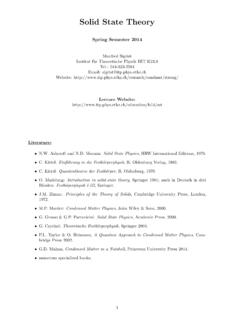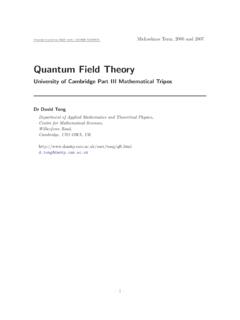Transcription of Week3HW S15 Solutions - nanoHUB
1 ECE 305 Spring 2015 ECE- 305 Spring 2015 1 Solutions : ECE 305 Homework: Week 3 Mark Lundstrom Purdue University 1) Assume Silicon (bandgap eV) at room temperature (300 K) with the fermi level located exactly in the middle of the bandgap. Answer the following questions. a) What is the probability that a state located at the bottom of the conduction band is filled? b) What is the probability that a state located at the top of the valence band is empty?
2 Solution: 1a) Begin with the fermi function: fE()=11+eE EF()kBT For our problem: E=EC fEC()=11+eEC EF()kBT e EC EF()kBT The approximation is extremely good, because the bottom of the conduction band is very far above the fermi level. The semiconductor is said to be nondegenerate. EF=EC+EV2 (The fermi level is exactly in the middle of the bandgap.) EC EF=EC EC+EV2=EC EV2=EG2 so the probability is fEC() e EC EF()kBT=e EG2kBT EG= kBT= EG2kBT= fEC()=e EG2kBT=e 10 10 What if we had not made the non- degenerate approximation?
3 Then fEC()=11+eEC EF()kBT=11+eEG2kBT=11+ 109= 10 10 Same answer as with the non- degenerate assumption because this semiconductor is non- degenerate. ECE 305 Spring 2015 ECE- 305 Spring 2015 2 HW3 Solutions (continued): 1b) Begin again with the fermi function: fE()=11+eE EF()kBT For this part: E=EV fEV()=11+eEV EF()kBT The fermi function gives the probability that a state is full. We want the probability that the state is empty, which is 1 fEV()=1 11+eEV EF()kBT=eEV EF()kBT1+eEV EF()kBT=1e EV EF()kBT+1 1 fEV()=11+eEF EV()kBT e EF EV()kBT The approximation is extremely good, because the fermi level is very far above the top of the valence band.
4 The nondegenerate approximation can be used for the valence band too. EF=EC+EV2 (The fermi level is exactly in the middle of the bandgap.) EF EV=EC+EV2 EV=EC EV2=EG2 so the probability is 1 fEV()=e EF EV()kBT=e EGkBT 1 fEV()=e EG2kBT= 10 10 As expected, when the fermi level is exactly in the middle of the bandgap, the probability that a state at the conduction band edge is occupied is exactly the same as the probability that a state at the valence band edge is empty.
5 2) For Si at room temperature, calculate the following quantities. (Numerical answers required, and don t forget to include units with your answers). a) The density of states in the conduction band, gCE(), at an energy 26 meV above EC. b) The density of states in the valence band, gVE(), at an energy 26 meV below EV. c) The effective density of conduction band states. NC. d) The effective density of valence band states, NV. e) Compute the ratio of the effective density of conduction band states to the atomic density of Si.
6 ECE 305 Spring 2015 ECE- 305 Spring 2015 3 HW3 Solutions (continued): Solution: 2a) Begin with the DOS expression (SDF, eqn.( ), p. 41) gCE()=mn*2mn*E EC() 2!3 E>EC gCE()=m02m0 2!3mn*m0 3/2E EC gCE()= 10 312 10 10 34()3mn*m0 3/2E EC (everything in MKS (SI) units) gCE()= 1056mn*m0 3/2E EC According to SDF, p. 34, mn*m0= gCE()= ()3/2E EC= 1056E ECJ-m3() 1 Note the units. This is the number of states per unit energy (in Joules) per unit volume (in cubic meters).
7 We are asked for the density of states 26 meV (milli electron volts) above the bottom of the conduction band. In Joules: E EC= 10 19= 10 21J eV+EC()= 10 211J-m3= 10451J-m3 The answer is correct, but the units are inconvenient. Let s express the answer per eV per cubic cm, which is the more typical way of doing things for semiconductors. eV+EC()= 10451J 10 19 JeV1m3 10 2mcm 3 eV+EC()= 10211eV- cm3 ECE 305 Spring 2015 ECE- 305 Spring 2015 4 HW3 Solutions (continued): Note: The total number of states in a range of energy of kBT= is approximately eV+EC() 10191cm3, which is a reasonable number, as we shall see below.
8 This answer is approximate, because to get the total number of states in the bottom kBT of the conduction band, we should do the integral NTOT=gCE()ECEC+kBT dE . A note about units. Calculations should be done in the MKS system of units (also called SI). All of the fundamental constants ( Plank s constant, Boltzmann s constant, rest mass of an electron, etc.) are in these units. After we have an answer, it is often convenient to convert to different units.
9 For example, in semiconductor work, we like to quote carrier and doping densities per cubic cm, not per cubic meter, which is the proper MKS unit. Be careful about units! 2b) Begin with the DOS expression (SDF, eqn.( ), p. 41) gVE()=mp*2mp*EV E() 2!3 E<EV gVE()=m02m0 2!3mp*m0 3/2EV E gVE()= 10 312 10 10 34()3mp*m0 3/2EV E (everything in MKS (SI) units) gVE()= 1056mp*m0 3/2EV E According to SDF, p. 34, mp*m0= ECE 305 Spring 2015 ECE- 305 Spring 2015 5 HW3 Solutions (continued): gVE()= ()3/2EV E= 1055EV EJ-m3() 1 Note that the DOS in the valence band is a little smaller than in the conduction band because the hole effective mass is smaller than the electron effective mass.
10 We are asked for the density of states 26 meV (milli- electron volts) below the top of the valence band. In Joules EV E= 10 19= 10 21J gCEV eV()= 10 211J-m3= 10451J-m3 The answer is correct, but the units are inconvenient. Let express the answer per eV per cubic cm, which is the more typical way of doing things for semiconductors. gVEV eV()= 10451J 10 19 JeV1m3 10 2mcm 3 gVEV eV()= 10201eV- cm3 Note: The total number of states in a range of energy of kBT= is approximately gVEV eV() 10191cm3 which is a reasonable number, as we shall see below.


